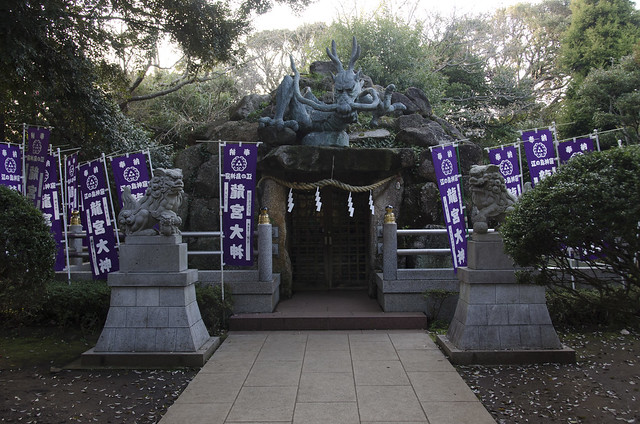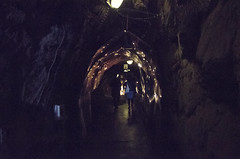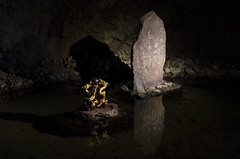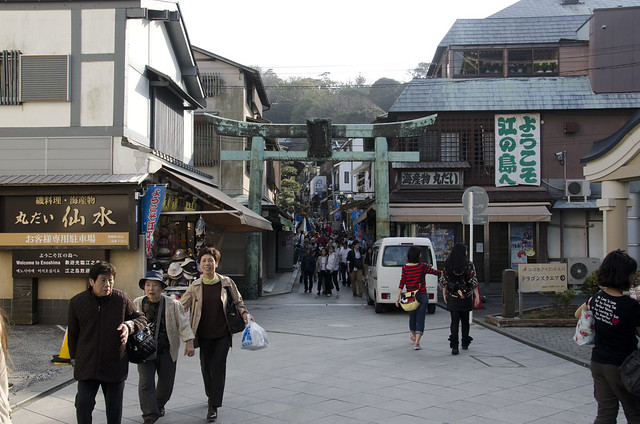1Yahoo!Answers assures me that it should take no longer than 40 minutes to circumnavigate. Don’t you tempt me, Yahoo!Answers!
, Enoshima (江ノ島) is a small island off the Kanagawa (神奈川) coast only a few stops from the 大仏 in Hase (長谷) along the historic, beach-gliding Enoden Train Line (江ノ島電鉄). Dedicated to Benzaiten, the Buddhist goddess of 'everything that flows,' the once-sacred island hangs at the end of a tombolo, an emerald necklace that dangles into the Pacific blue from the proud neck of 神奈川県.
Believed to be raised from the sea floor by the goddess herself, the island houses three temples in her honor, the most notable of which memorializes her love affair with and then subsequent banishment of a five headed dragon that had begun terrorizing the island and surrounding area. Well, technically, the most notable temple is the one with a nude statue sculpted in her honor, but the dragon one has to be at least top two.

The main draw of the island, apart from its adopted tropical feel and semi-decent views of the southern coast, are the Iwaya (岩屋) Caves.
At the end of an arduous hike up and down OSHA-disapproved stairs over the twin-peaks that make up the core of Enoshima2
2Heaven forbid that a Japanese monk dare to walk BETWEEN two hills.
, one finds a slippery-when-wet walkway among tidal pools and sharp fangs of death that leads to a set of turnstiles [¥$5].These cool, quiet caves are a relaxing return to the more touristy philosophies of Japan.



Carved out of the side of the rock-face by centuries of waves, the narrow, low-ceilinged bores offer tourists a genuine Legend of Zelda experience, complete with random Buddha statuettes floating in calm, dark cave ponds, carvings of dragons guarding semi-precious stones, and even a couple of hovering, illuminated triforce symbols.
Okay, so they are rather the family crest (家紋) of the 北条 (ほうじょう) Clan, prolific in the Kanagawa area as the Kamakura Shogunate. But as it stands, the more I explore Japan, the more I realize that Japanese videogames were interesting not for what appeared to be their astounding creativity in producing magical other-worlds, but in their ability to recognize these other worlds in their backyards and incorporate them into their design.
However, probably of more interest3
3Or, “Of interest to more people.”
, is that the second of the two caves is dedicated to the dragon deity that once inhabited the island. Complete with carved, gold-leafed statues and jewel encrusted figurines, the East-Cave of Iwaya stands in reverence to the monster that long ago terrorized the residents of Kanagawa.Of course, the other legends say that this dragon-terror came as a response to the prayers of 北条 時政 (ときまさ・ほうじょう), the first Hojo Regent. The story goes that Hojo arrived on the island of Enoshima bearing with him prayer and supplication for the prosperity of his offspring (then the father-in-law of 源 頼朝, みなもと・の・よりとも, the first shogunate of Kamakura). At his call, a dragon appeared4
4I like to imagine it was all Dragon-Ball-like. No, not that Dragon Ball… THIS Dragon Ball.
, answering his prayer with a promise of protection for the harbor, a promise sealed with three triangular dragon scales, which is at the root of the design of their kamon.Now, a few logistics: the far side of the island pretty much runs on temple-time. This basically means that everything closes in time for the early-bird special. This usually means that, in the summer, everything closes before the sun goes down at around 5. However, it will probably take you only 120 minutes to walk through most of the ‘historical’ parts of the island5
5I’m not quite sure what the Japanese conversion is on that, but most of that time will be comprised of you getting TO the historical parts of the island.
.That being said, it is a nice half-day excursion. Trying to pack it in with Kamakura, however, was a little dicey, as all we could really do was get to Enoshima, take the escalators, and then run to the caves before everything closed. Of course, that did offer us a nice, leisurely stroll back through the quaint island village, as there is literally only one road that bisects the island. It’s pretty hard to miss something.
Speaking of the escalators, do it. Don’t be that fool. Now there aren’t a lot of stairs, perse. Not at least compared to Zhangjiajie City or Abhaneri, but even then, what you save in terms of efficiency-for-cost just cannot be beat. After all, even if you get a curious longing for what sights you’d possibly miss by taking the express escalator, rest assured: the escalators only go up so you’ll be walking down every single one of those stairs in the end.
But we’re getting ahead of ourselves.
Your approach begins, as most do in Japan, as a long walk from the train station through a quaint village town remarkable for its unremarkable Miami Beachfront impression. Actually, with its broadly appealing, flat wood-scaping, gravel lawns and stenciled palm trees, it felt more like approaching Redondo Beach from Knob Hill or Avenue G.
This short downhill ends at the bottom of a 4-way road underpass that births you out in front of a half-mile long walkway that buttresses a narrow shoal connecting Enoshima to the larger landmass. Pro-tip regarding this bridge: take the bus.
The entire approach, with camera in hand, I was hoping to experience one of those ‘cresting’ moments, where, because sightlines become obscured by the rise of the bridge, the divine breeches into view at the crest of the cobbled walkway as a beautiful gem pulled from the depths of the sea, glistening in the high, nautical sun. But the approach offers no such reveal. And while the island is a delightful mossy marble floating on haze and currents, skirted in the muted tones of luxury spas and patchwork village port town, there is nothing that would be lost seen through a metro-bus window.

And yet, just as unremarkable as the approach is is the port town built to act as your reception: an indiscernible hodgepodge of buildings and luxury spas of no particular make or influence. One immediately gets the sense that this particular style of unremarkableness hides a particularly remarkable secret.
But it’s no secret.
Since its founding as a pleasure garden in the late 19th century, Enoshima has since grown to become the heart of Shonan, a resort area that runs along the coast of Sagami Bay, which features the closest sandy beaches to the Kanto area.
In particular, what is not so interesting is that its beaches are kinda bland, and surf particularly weak, and the island has no direct access to natural hot-spring water. So one wonders what exactly made Enoshima, the sacred island, such a leisure hot-spot in the first place.
Nearly 20 years into their rule, and more than 10 after moving the capitol from Kyoto to Tokyo, the Meiji government [明治政府 (めいじせいふ)], in its bid to restore Japan to a more pure form of Japaneseness, wrote into law a separation of Shintoism and Buddhism in a policy called 神仏分離 (しんぶつぶんり)6
6カシェウ Saiz: Buddhism first entered into Japan during the Asuka period, at which time Shinto was the official religion of the royal family. However, under the guidance of Prince Shotoku Taishi (574-622AD), a Buddhist state was established by syncretizing both systems of deities, allowing Buddhism to gain a foothold in society, which only flourished during the Tokugawa period. Beginning in 1633, in response to the influx of Western trade and influence, Japan closed its gates (鎖国) and put a heavy emphasis on Buddhism to stem the spread of Christianity. While this effectively pushed Christianity out of Japan, this move towards Buddhism meant that more and more individuals were straying away from the country’s mother religion. Under the auspice of returning Japan to its Japanese roots during the Meiji Restoration (1868) the government tried to recenter the country on Shinto principles (which conveniently would include the deification of the Emperor) by installing a new policy: The Shinbutsu-Bunri. The policy’s written focus was to separate the Buddhist and Shinto states from each other. However, in actuality, the policy was cause to forcibly remove Buddhism from Shinto. This lead to the desecration of many temples with much of the land being taken and sold to merchants. The few who were able to maintain their properties did so by forging new temple histories. However, by falsifying these historical records to preserve the temple sites, the original stories have been lost forever.
.This new law forced the release of Buddhist-held properties, including the sacred island of Enoshima, opening the door for land prospectors to swoop in to develop the most coveted and picturesque real estate of the time: temple property. In 1880, one Samuel Cocking, a British merchant wed to a Japanese woman, used his wife’s registry to purchase much of the under-developed high lands, turning it into a luxury garden and thriving port-town.
Kashew and I didn’t take the time to walk the pay-to-see luxury gardens, though the rest of the island’s pleasure gardens are quite quaint and relaxing. The Cocking-areas are, more or less, appropriately named for being romantically themed with snug benches possessing overlooking views of the shore or sea. They’re cute, even if it weren’t for the overabundance of friendly cats. But, again, the work-husband and I did not venture into the heart of the Love-Tunnel that was the Samuel Cocking Garden and Greenhouse. And phallicly inspired Observation Tower.
It’s a solid recommendation for anyone who has only a few things left to do in Kamakura for a second or third trip. Much more relaxing than fighting tourists in Hase or pounding the pavement in Kita-Kamakura. Of course, now I have to go back because we didn’t allocate enough time to see the Enoshima Aquarium, which was not actually on the island. Nor was it particularly visible from the island.
No comments:
Post a Comment